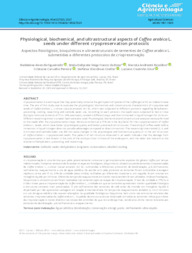Physiological, biochemical, and ultrastructural aspects of Coffea arabica L. seeds under different cryopreservation protocols.
Physiological, biochemical, and ultrastructural aspects of Coffea arabica L. seeds under different cryopreservation protocols.
Autoria: FIGUEIREDO, M. A. de; ROSA, S. D. V. F. da; RICALDONI, M. A.; PEREIRA, C. C.; COELHO, S. V. B.
Resumo: Cryopreservation is a technique that may potentially conserve the germplasm of species of the Coffea genus for an indeterminate time. The aim of this study was to evaluate the physiological, biochemical and ultrastructural characteristics of cryopreserved seeds of Coffea arabica L., cultivar Catucaí amarelo IAC 62, which was subjected to different protocols regarding dehydration, precooling, cooling, rewarming and cathode water use. According to each protocol, the seeds were subjected to fast or slow drying to moisture contents of 17 or 20% (wet basis), cooled in different ways, and then immersed in liquid nitrogen for 24 hours. Different rewarming times in a water bath were also used. Physiological, biochemical and ultrastructural analyses were performed on the seeds after the cryopreservation steps. Moisture content at a 17% wb is the key factor for the cryopreservation of Coffea arabica L. seeds, which have better physiological quality and better preserved cell structures. Precooling of coffee seeds before immersion in liquid nitrogen does not provide advantages compared to direct immersion. The rewarming times tested (2, 4, and 6 minutes) and cathode water use did not cause changes in the physiological and biochemical quality or in the cell structures of Coffea arabica L. cryopreserved seeds. The pattern of cell structure observed in all seeds indicates that the damage from cryopreservation is less drastic in the cells of the embryos than in those of the endosperm, with the latter less tolerant to the stresses of dehydration, precooling, and rewarming.
Ano de publicação: 2021
Tipo de publicação: Artigo de periódico
Unidade: Embrapa Café
Palavras-chave: Bioquímica Vegetal, Coffea Arábica, Conservação, Desidratação, Fisiologia, Resfriamento, Semente
Observações
1 - Por padrão são exibidas publicações dos últimos 20 anos. Para encontrar publicações mais antigas, configure o filtro ano de publicação, colocando o ano a partir do qual você deseja encontrar publicações. O filtro está na coluna da esquerda na busca acima.
2 - Para ler algumas publicações da Embrapa (apenas as que estão em formato ePub), é necessário ter, no celular ou computador, um desses softwares gratuitos. Sistemas Android: Google Play Livros; IOS: iBooks; Windows e Linux: software Calibre.
Acesse outras publicações
Acesse a Base de Dados da Pesquisa Agropecuária (BDPA) para consultar o acervo completo das bibliotecas da Embrapa.

